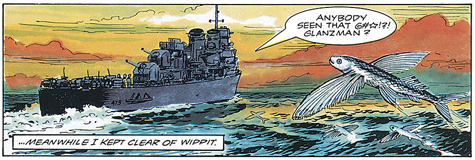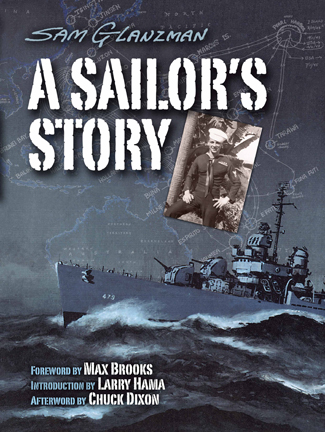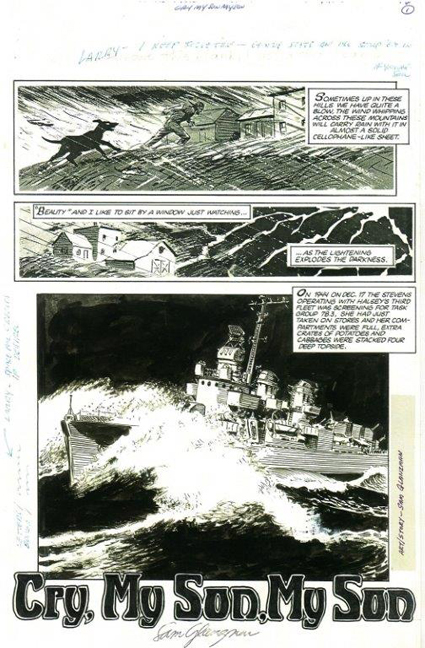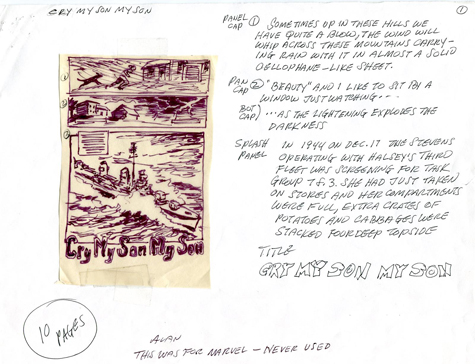Drew Ford Discusses Sam Glanzman's A Sailor's Story
Feb 19, 2015
by Ashley Hurst
Dover Publications recently unveiled their new Dover Graphic Novel line, which will give comic lovers access to classic, out-of-print titles! With new forewards and introductions by some of the most prominent comic creators working today, previously unpublished material, and updated cover art, these new editions are sure to be a fantastic addition to any reader's library. To celebrate the occasion, PREVIEWSworld spoke with Dover's acquisitions editor Drew Ford (who will oversee this new publishing venture) about the line's inaugural title, Sam Glanzman's A Sailor's Story! Read our interview below (and be sure to check out our up-close peek at how Mr. Glanzman creates his comics), and be sure to pre-order A Sailor's Story (FEB151370) at your local comic shop today!
PREVIEWSworld: Drew, thank you for taking time to speak with us about the launch of Dover’s new graphic novel line and, specifically, Sam Glanzman’s A Sailor’s Story! For starters, can you please tell us a bit about your work at Dover and provide readers who may be new to A Sailor’s Story a brief overview of the book?
Drew Ford: To give you a brief history, I have been involved with comic books on some level for the last 20 years. As a creator, I started out self-publishing my own underground comics, before finding myself doing full size comic book work at companies like Caliber, and eventually graduating to work more recently at DC and Dark Horse. I have also edited and published others’ work over the years, and even worked in comics retail a few times. My job at Dover consists of delving back into the past, digging out what I feel are important graphic novels and uncollected comic book runs which deserve to be brought back into a print, both for the original readers and so they might be discovered and enjoyed by future generations of comic book fans.
A Sailor’s Story, simply put, is an account of one man’s time aboard the U.S.S. Stevens Destroyer, during World War II. That man is Golden Age comic book and WWII veteran Sam Glanzman, and other than a few changes for legal reasons (such as the names of his shipmates), the stories are 100% true.
PREVIEWSworld: A Sailor’s Story has had an interesting publishing history, to say the least! The story first appeared in Savage Tales, a comic anthology magazine produced by Marvel and was later collected for a hardcover release. How did Dover come to pick up the project? How did Dover go about producing this new edition of the story?
Drew Ford: The publishing history of A Sailor’s Story goes as follows…
Larry Hama, who was a writer and editor at Marvel in the 1980s, loved Sam Glanzman’s short U.S.S. Stevens back-up stories created for DC Comics during the 1970s, and asked him to consider doing a larger, more personal version of these stories, casting himself as the main character of a graphic novel. Sam agreed, and A Sailor’s Story was born. After completing two A Sailor’s Story graphic novels for Marvel, Larry invited Sam to contribute to the second volume of Marvel's Savage Tales, which Larry revived and was editing at the time. Sam ended up creating 3 more U.S.S. Stevens stories, which were closer in look and feel to his original U.S.S. Stevens stories of the 1970s, except that they were a bit longer and had a darker or more intense vibe.
The Sailor’s Story graphic novels were something that I personally believed should have been reprinted by someone a long time ago. I even had a letter published years ago in the Comics Buyer’s Guide which expressed the importance of both Sam’s career and his Sailor’s Story graphic novels. Therefore, when the opportunity to reprint a series of classic graphic novels came up here at Dover, the first book I thought of was A Sailor’s Story. From there it was a series of e-mails and phone calls between Marvel, Sam and ourselves, until we had worked things out and were able to move forward with this new collection.
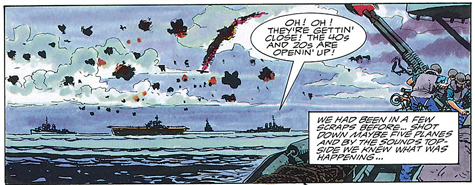
PREVIEWSworld: War stories have been popular throughout comic history, but A Sailor’s Story sets itself apart from many other war-related tales by being autobiographical. Do you know what inspired Mr. Glanzman to put down his personal stories and experiences in comic form as opposed to creating a work of fiction? As A Sailor’s Story was produced and published several decades after his service in WWII, how did Mr. Glanzman go about recalling and translating his memories to a comic format?
Drew Ford: I asked Sam what inspired him to do this book, and he told me simply that he realized there were stories to tell. Also, it came quite easy compared to some of his other work, because he didn’t have to make any of it up. It was real, he lived it! As for why he would create it as a graphic novel as opposed to a prose novel? Sam has been getting paid to draw comics since 1939. When it comes to telling stories, comics is the only medium he has ever used. So when the opportunity to tell his OWN story came along, it made sense for him to stick with what he knew best…comics!
When asked about how he was able to remember something that happened decades earlier, Sam explained that while a lot of it he simply had to remember, he did have the aid of several ship’s logs, naval documents and of course his own journals, both written and illustrated, to draw from when creating A Sailor’s Story.
PREVIEWSworld: Mr. Glanzman is undoubtedly and extremely skilled draftsman—his pages are meticulously rendered and full of energetic, lifelike detail! Did he have to do any additional research to bring the U.S.S. Stevens, its inhabitants, and the battles it endured to life? In terms of actually creating a comic page, what kind of steps are involved in his creative process (e.g. thumbnailing, penciling, inking, coloring, etc.)?
Drew Ford: Sam told me that he starts with doodles and sketches, which then get turned into thumbnails and page roughs, and from there he does the final pencil and inks. He writes the actual script of the stories right next to the thumbnails, so you won’t find a lot of traditional typed scripts.
Drew and Mr. Glanzman were kind enough to provide us a glimpse at ten different pages of thumbnails and scripts for an unused U.S.S. Stevens story entitled "Cry, My Son, My Son." You can download a full-sized PDF of the pages at this link!
PREVIEWSworld: Finally, why do you believe A Sailor’s Story is an important title to re-visit?
Drew Ford: A Sailor’s Story is not only important for being a record of what life was like aboard a Destroyer during World War II, it is important because this timeless story is being told through sequential art. Of course, the most important thing about A Sailor’s Story is that is true, and being told to us by the man who lived it.
